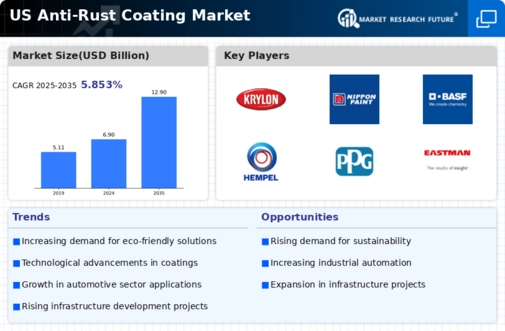The anti rust coating market in the US is characterized by a competitive landscape that is increasingly shaped by innovation, sustainability, and strategic partnerships. Key players such as Sherwin-Williams (US), PPG Industries (US), and AkzoNobel (US) are actively pursuing strategies that emphasize product development and market expansion. Sherwin-Williams (US) has focused on enhancing its product portfolio with eco-friendly formulations, which aligns with the growing demand for sustainable solutions. PPG Industries (US) has been investing in digital transformation initiatives to streamline operations and improve customer engagement, while AkzoNobel (US) is leveraging its global presence to penetrate emerging markets, thereby enhancing its competitive positioning.
The market structure appears moderately fragmented, with several players vying for market share. Companies are adopting various business tactics, such as localizing manufacturing to reduce costs and optimize supply chains. This approach not only enhances operational efficiency but also allows for quicker response times to market demands. The collective influence of these key players contributes to a dynamic competitive environment, where agility and innovation are paramount.
In November 2025, Sherwin-Williams (US) announced the launch of a new line of anti rust coatings designed specifically for marine applications. This strategic move is significant as it addresses a niche market that has been underserved, potentially capturing a new customer base and reinforcing the company's commitment to innovation. The introduction of specialized products may also enhance brand loyalty among marine industry professionals.
In October 2025, PPG Industries (US) unveiled a partnership with a leading technology firm to integrate AI-driven analytics into its supply chain management. This initiative is likely to optimize inventory levels and reduce lead times, thereby improving overall operational efficiency. The integration of advanced technologies reflects a broader trend within the industry towards digitalization, which is becoming increasingly critical for maintaining competitive advantage.
In September 2025, AkzoNobel (US) expanded its production capabilities by investing in a new facility focused on sustainable coating solutions. This expansion not only signifies a commitment to sustainability but also positions the company to meet the rising demand for eco-friendly products. Such strategic investments are essential for long-term growth and align with the industry's shift towards environmentally responsible practices.
As of December 2025, current trends in the anti rust coating market indicate a strong emphasis on digitalization, sustainability, and technological integration. Strategic alliances are becoming increasingly important, as companies seek to leverage complementary strengths to enhance their market positions. The competitive landscape is evolving, with a noticeable shift from price-based competition to a focus on innovation, technology, and supply chain reliability. This evolution suggests that companies that prioritize these aspects will likely achieve greater differentiation and success in the future.






















Leave a Comment